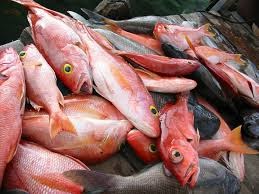Is Your Favorite Fish Eco-friendly? Find Out Here!
3 min read
I don’t know about you, but I absolutely LOVE seafood! I could eat it three times a day, seven days a week. So, needless to say, I was a little distressed to find that one of my all-time favorite fish (Chilean sea bass) is categorized as “Eco-Worst.” I did, however, see a lot of goodies on the “Eco-Best” list.
The Environmental Defense Fund (EDF) uses several criteria to determine which fish merit an “Eco-Best,” “Eco-Ok,” or “Eco-Worst” rating. Eco-Best fish are defined as wild fish from healthy, well-managed populations that are caught with fishing gear that causes the minimum amount of harm to sea life and marine habitats; or farm-raised fish that are raised in systems where pollution, spread of disease, chemical use and escaped fish are controlled. Incidentally, the majority of the fish that fall into the “Eco-Best” category are also low in environmental contaminants and can be safely eaten at least once a week. Eco-OK fish are generally okay for the environment and can be enjoyed in moderation, but they have mixed records on the health of their habitat, how they’re managed, or how they’re caught or farmed. Some of these fish may also have elevated levels of environmental contaminants, like mercury or PCB’s. The Eco-Worst choices have at least one or more of the following serious environmental issues: overfished populations, extensive damage to the habitat, or they come from farms that allow the spread of pollution, disease, chemical use and escaped fish. Not coincidentally, several of the fish on this list have higher levels of mercury or PCB’s and should be eaten in moderation, if at all, according to the EDF. Click “read more” to see how your favorites rate.
*Please note: while some fish may appear to be listed more than once, they’re often differentiated by location and how they are caught.
Eco-Best:
| By Lord Mountbatten (Own work) [CC-BY-SA-3.0 (http://creativecommons.org/licenses/by-sa/3.0)], via Wikimedia Commons |
- Anchovies
- Catfish
- Caviar (farmed)
- Clam, softshell
- Crab, Dungeness
- Clams (farmed)
- Cod, Pacific
- Crab, stone
- Crawfish (U.S.)
- Halibut (Pacific)
- Lobster, California & Caribbean spiny (U.S.)
- Mackerel (Atlantic)
- Mahi-mahi (U.S.)
- Mullet
- Mussels
- Oysters (farmed)
- Pollock, Alaska (U.S.)
- Prawns (Canada)
- Salmon (canned)
- Salmon, wild (Alaska)
- Sardines, Pacific (U.S.)
- Scallops, Bay (farmed)
- Shrimp, pink (Oregon)
- Squid, longfin (U.S.)
- Striped bass (farmed)
- Sturgeon, white (farmed)
- Tilapia (U.S.)
- Trout, rainbow (farmed)
- Tuna, albacore (U.S., Canada)
- Tuna, yellowfin (U.S. Atlantic pole)
Eco-OK:
| King Crab |
- Bluefish
- Caviar, white sturgeon (Oregon, Washington)
- Clams (wild)
- Crab, blue
- Crab, king (U.S.)
- Crab, snow
- Flounder/sole (Pacific)
- Haddock
- Lobster, American/Maine
- Mahi-mahi (U.S. longline)
- Oysters (wild)
- Rockfish
- Salmon (wild WA)
- Scallops, sea (U.S., Canada)
- Sea bass, black
- Shrimp (U.S. wild)
- Swordfish (U.S.)
- Tilapia (Latin America)
- Tilefish
- Tuna, yellowfin (imported)
Eco-Worst:
| Chilean Sea Bass |
- Caviar, wild (imported)
- Chilean sea bass
- Cod, Atlantic
- Crab, king (imported)
- Crawfish (China)
- Eels, freshwater
- Flounder/Sole (Atlantic)
- Grouper
- Haddock (trawl)
- Halibut, Atlantic
- Lobster, Caribbean spiny
- Mahi-mahi (imported longline)
- Monkfish
- Octopus
- Orange roughy
- Salmon, farmed/Atlantic
- Sea urchin (Maine)
- Shark
- Shrimp/prawns (imported)
- Skate
- Snapper (imported)
- Snapper, red
- Snapper, silk
- Swordfish (imported)
- Tilapia (Asia)






